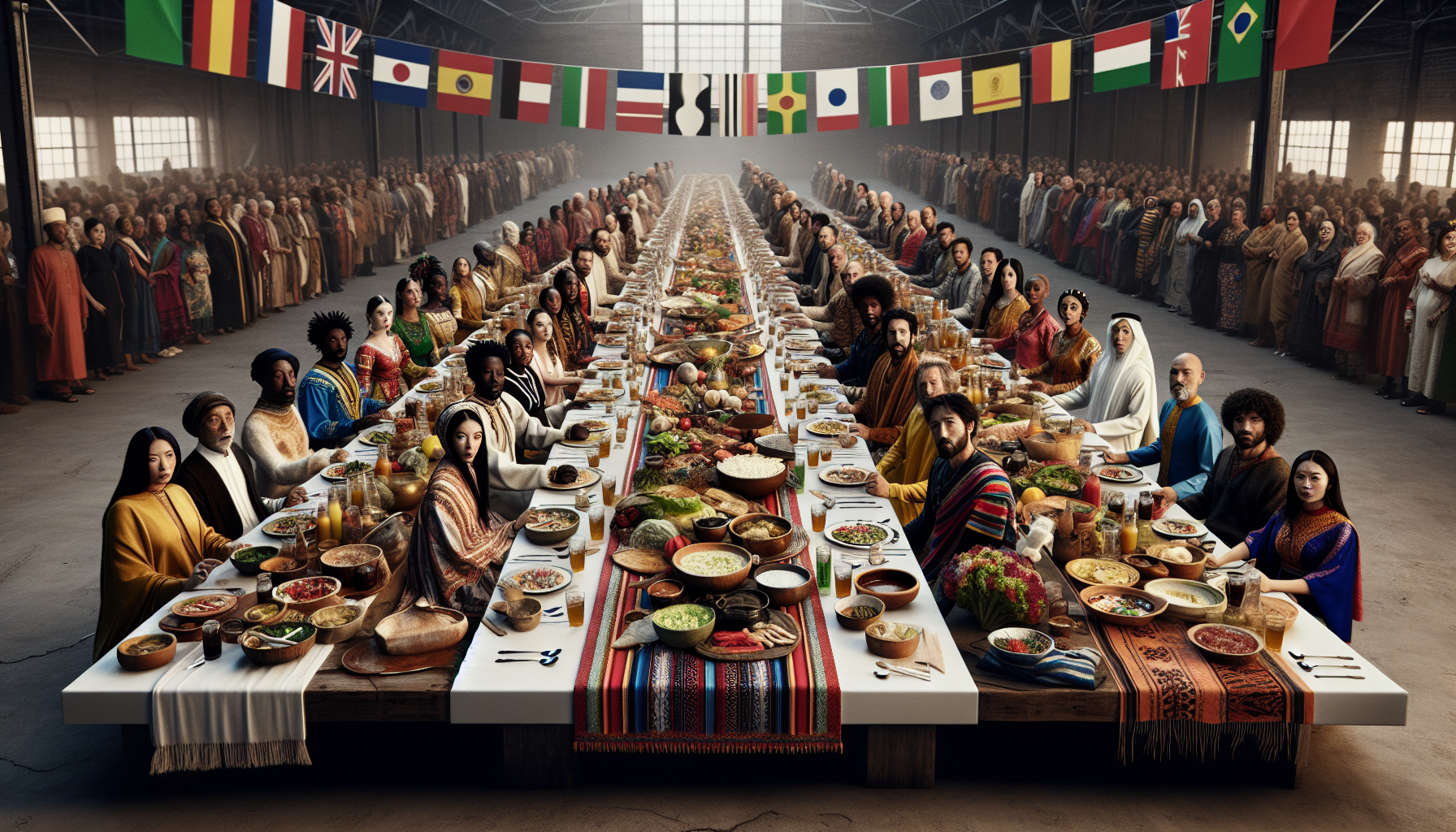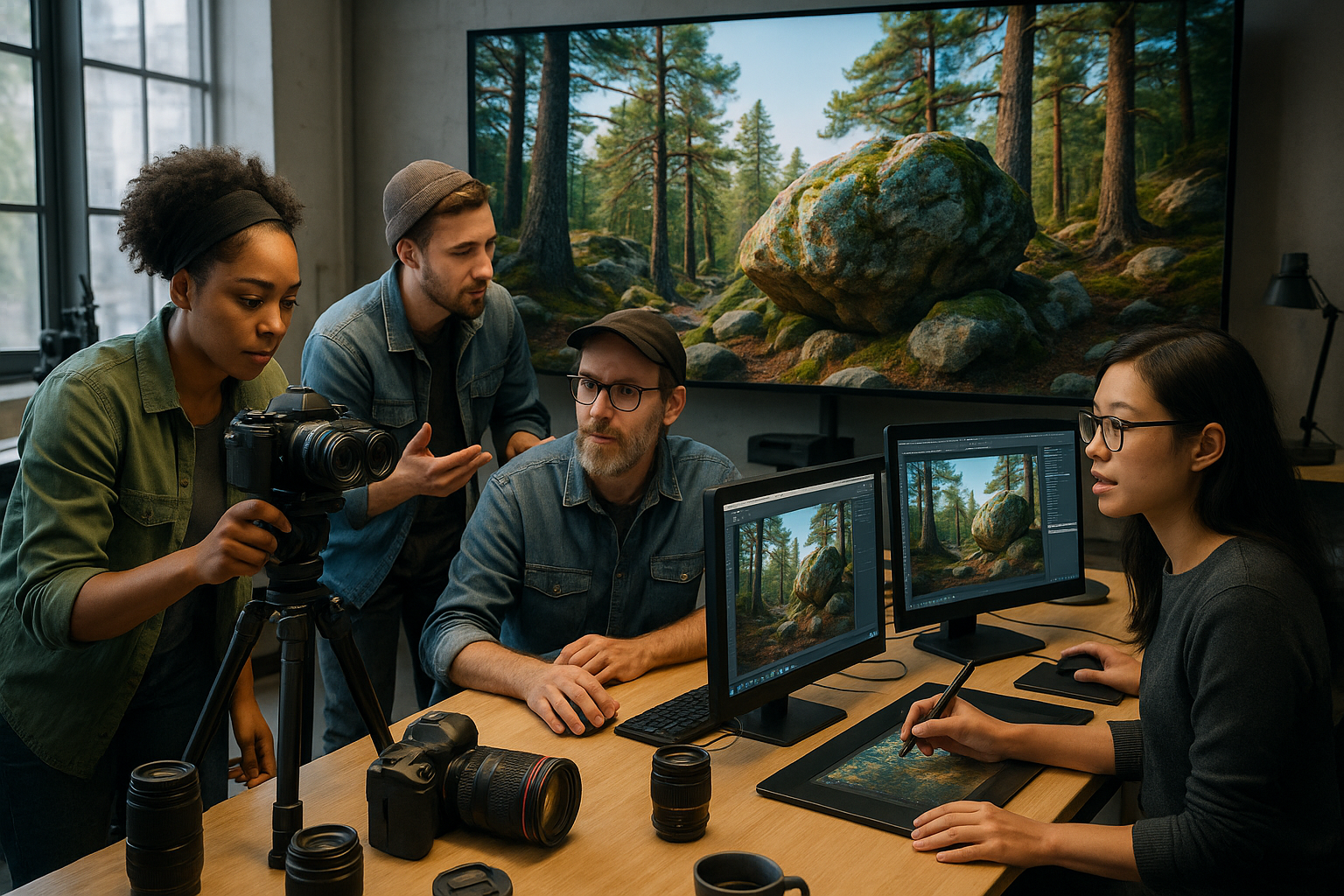In a world that is increasingly interconnected yet persistently diverse, the tapestry of cultural interpretations offers a rich and fascinating landscape to explore. Imagine a vast mosaic, each tile representing a unique cultural perspective, tradition, or belief system. This intricate mosaic not only defines individual communities but also contributes to the global narrative that shapes our collective understanding. From the vibrant festivals of India to the solemn rituals of Japan, from the intricate storytelling of African tribes to the philosophical musings of ancient Greece, cultural interpretations are the threads that weave the fabric of human experience. In this blog post, we invite you on a journey to explore these diverse perspectives, seeking to understand how they inform and enrich our lives today. 🌍
At its core, culture serves as a lens through which we interpret the world around us. It influences our perceptions, dictates our values, and shapes our identities. Yet, it is easy to overlook the depth and complexity of these cultural interpretations in our fast-paced, modern world. To truly appreciate this richness, we must delve deeper, examining the historical contexts, societal structures, and philosophical underpinnings that give rise to such diversity. In doing so, we can uncover the common threads that connect us, even as we celebrate the differences that make each culture unique. This exploration is not just an academic exercise; it is an opportunity to foster empathy, broaden our horizons, and ultimately, find our place in the global community.
Throughout this article, we will explore several key themes that highlight the beauty and complexity of cultural interpretations. We will begin by examining the role of tradition and its influence on cultural identity. Traditions serve as a bridge between the past and the present, preserving the wisdom of previous generations while adapting to the needs of contemporary society. Next, we will delve into the power of language as a cultural tool, exploring how words can both unite and divide us, shaping our reality in profound ways. We will also consider the impact of globalization, questioning whether it threatens cultural diversity or provides an opportunity for cross-cultural exchange and enrichment. Finally, we will look at the role of art and storytelling in preserving cultural heritage, and how these creative expressions allow cultures to convey their unique worldviews to future generations.
As we embark on this journey through the myriad interpretations of culture, let us remain mindful of the transformative power of understanding and appreciation. By approaching each culture with curiosity and respect, we open ourselves to new ways of thinking and being. We invite you to join us in this exploration, to embrace the complexity and beauty of the world’s cultural tapestry. Through this lens, we can learn not only about others but also about ourselves, recognizing that in our shared humanity, there is both strength and beauty. Let us begin this deep dive into diverse perspectives and traditions, ready to uncover the stories that connect us all. 🌐
Understanding Cultural Interpretations: An Introduction
Cultural interpretations are the lenses through which we view the world, shaping our perceptions, beliefs, and actions. These interpretations are deeply rooted in traditions, history, and societal norms, influencing everything from individual behaviors to global relations. As we navigate an increasingly interconnected world, understanding these diverse perspectives becomes crucial. Through this exploration, we delve into how cultural interpretations vary across different societies and how they impact our interactions and understandings.
The richness of cultural interpretations lies in their diversity. From the folklore of indigenous tribes to the philosophies of ancient civilizations, each culture offers a unique perspective on life, ethics, and existence. This diversity is not just about differences but also about the shared human experiences that bind us together. By studying these cultural interpretations, we gain insight into the values and priorities of different societies, fostering empathy and global awareness.
Let’s embark on a journey to explore these cultural tapestries, examining the intricate patterns woven by history, geography, and social dynamics. This deep dive will cover various aspects of cultural interpretations, including art, religion, and social norms, offering a comprehensive view of how cultures perceive and interact with the world. We will also consider how these interpretations evolve over time, adapting to new influences and challenges.
The Role of Art in Cultural Interpretations
Art as a Reflection of Society
Art has always been a powerful medium for expressing cultural interpretations. It serves as a mirror, reflecting the values, beliefs, and experiences of a society. Through paintings, sculptures, music, and literature, artists convey the essence of their culture, providing insight into the collective consciousness of their communities. Art not only preserves cultural heritage but also challenges societal norms, prompting reflection and dialogue.
Consider the murals of Diego Rivera, which depict the struggles and triumphs of the Mexican people. These works are more than artistic expressions; they are narratives of cultural identity and social justice. Similarly, the music of Bob Marley transcends entertainment, offering messages of resistance and unity that resonate with audiences worldwide. Art, in its various forms, becomes a universal language that communicates cultural interpretations across boundaries.
To further understand the impact of art on cultural interpretations, let’s look at a comparative table of different art forms and their cultural significance:
| Art Form | Cultural Significance | Example |
|---|---|---|
| Painting | Represents historical events and societal values | The Starry Night by Vincent van Gogh |
| Music | Expresses emotions and cultural narratives | Imagine by John Lennon |
| Dance | Communicates traditions and communal stories | Swan Lake by Pyotr Ilyich Tchaikovsky |
| Literature | Explores philosophical themes and human conditions | One Hundred Years of Solitude by Gabriel García Márquez |
For a more in-depth exploration, watch this enlightening video on how art shapes cultural interpretations: Understanding Art and Culture – Art Channel.
Religious Beliefs and Their Influence on Culture
Religion as a Guiding Force
Religion plays a pivotal role in shaping cultural interpretations, offering a framework for understanding life’s mysteries and guiding moral conduct. Across the globe, religious beliefs influence traditions, social structures, and even political systems. They provide communities with a sense of identity and purpose, fostering cohesion and continuity.
In Hinduism, the concept of Dharma emphasizes duty and righteousness, guiding individuals in their daily lives and interactions. This religious principle permeates various aspects of Indian culture, from social hierarchy to artistic expressions. Similarly, Buddhism’s teachings on compassion and mindfulness influence cultural practices in countries like Thailand and Japan, where meditation and peaceful coexistence are highly valued.
Let’s examine a table that highlights the influence of major world religions on cultural practices:
| Religion | Core Belief | Cultural Impact |
|---|---|---|
| Christianity | Salvation through Jesus Christ | Festivals like Christmas and Easter; moral teachings in literature |
| Islam | Submission to the will of Allah | Ramadan fasting; architectural marvels like mosques |
| Hinduism | Dharma and karma | Temple rituals; influence on art and music |
| Buddhism | Four Noble Truths | Meditation practices; Zen gardens and minimalist art |
Religion’s influence on culture is profound and multifaceted. To gain a deeper understanding, watch the following video that explores how religious beliefs shape cultural norms: Religion and Culture – Global Faith Channel.
Social Norms and Their Cultural Significance
Understanding Social Constructs
Social norms are the unwritten rules that govern behavior within a society. They reflect cultural interpretations of acceptable conduct and influence how individuals interact with one another. These norms vary widely across cultures, shaped by historical events, geographic conditions, and societal values. By examining social norms, we gain insight into the priorities and principles of different cultures.
In Japan, for example, the concept of ‘Wa’ emphasizes harmony and group cohesion. This cultural interpretation manifests in social norms that prioritize politeness and respect, from bowing as a form of greeting to the meticulous attention to detail in business interactions. In contrast, Western cultures often value individualism and direct communication, reflected in norms that encourage self-expression and assertiveness.
Let’s explore a table comparing social norms across different cultures:
| Culture | Social Norm | Significance |
|---|---|---|
| Japanese | Emphasis on politeness and humility | Maintains social harmony and respect |
| American | Encouragement of individualism | Fosters innovation and personal freedom |
| Middle Eastern | Hospitality and generosity | Strengthens community bonds and trust |
| Scandinavian | Equality and consensus | Promotes social welfare and collaboration |
To explore the impact of social norms on cultural interpretations, watch this insightful video: Social Norms and Culture – Sociology Insights.
The Evolution of Cultural Interpretations Over Time
Adapting to Change
Cultural interpretations are not static; they evolve over time, influenced by internal dynamics and external factors. Globalization, technological advancements, and intercultural exchanges contribute to the continuous reshaping of cultural perspectives. As societies encounter new ideas and experiences, they adapt their interpretations to align with contemporary realities.
Consider the impact of technology on communication and cultural expression. The rise of social media has transformed how cultures interact and share information, breaking down geographical barriers and facilitating the exchange of ideas. This technological shift has led to the emergence of new cultural phenomena, such as digital art and online communities, reflecting the dynamic nature of cultural interpretations.
To visualize how cultural interpretations evolve, refer to the following table highlighting key influences on cultural change:
| Influence | Description | Example |
|---|---|---|
| Globalization | Interconnectedness of world economies and cultures | Fusion cuisine blending different culinary traditions |
| Technology | Advancements in communication and information sharing | Virtual reality experiences in cultural exhibitions |
| Migration | Movement of people across borders | Cultural festivals celebrating diverse heritages |
| Education | Exchange of knowledge and cultural understanding | Multicultural curricula in schools |
To explore the evolution of cultural interpretations further, watch this engaging video: Cultural Evolution in the Modern World – Culture Channel.

Conclusion
In conclusion, our exploration of the diverse tapestry of cultural interpretations has shed light on the intricate and multifaceted nature of human societies. Throughout this article, we have traversed the rich landscapes of cultural diversity, unraveling the layers of tradition, belief, and practice that define different communities across the globe. By examining these diverse perspectives, we have not only enriched our understanding of what culture entails but have also come to appreciate the beauty and complexity inherent in human expression.
We began by delving into the concept of culture itself, discussing its definition and the various elements that comprise it, such as language, art, religion, and social norms. Understanding these components is crucial, as they form the foundation upon which cultural identities are built. We then explored the role of cultural interpretations in shaping worldviews, influencing everything from interpersonal relationships to international diplomacy. This underscores the importance of cultural literacy in today’s interconnected world, where interactions between diverse groups are more common than ever.
Our journey took us through several case studies that highlighted the diversity of cultural interpretations. We examined how different societies celebrate and commemorate significant life events, such as births, marriages, and deaths, each with its unique customs and traditions. For instance, the elaborate wedding ceremonies in India contrast sharply with the minimalist approach observed in Scandinavian countries, yet both hold profound significance for the communities involved. Such examples illustrate that while the expressions of culture may vary, the underlying human experiences they represent are universal.
Another critical aspect we explored was the impact of globalization on cultural interpretations. While globalization has facilitated the exchange of ideas and traditions, leading to greater cultural understanding and appreciation, it has also posed challenges, such as the potential erosion of local customs and identities. The balance between embracing global influences and preserving cultural heritage is delicate, requiring thoughtful navigation to ensure that cultural diversity is celebrated rather than homogenized.
Furthermore, we discussed the role of technology in the dissemination and evolution of cultural interpretations. The digital age has enabled cultures to reach wider audiences, fostering cross-cultural dialogue and collaboration. Platforms like social media have become arenas where cultural exchange happens rapidly, allowing for a more nuanced understanding of global cultures. However, this also raises questions about cultural appropriation and the need for respectful engagement with cultures that are not one’s own.
The significance of this discussion extends beyond mere academic interest; it holds practical implications for how we engage with the world around us. By cultivating cultural awareness and sensitivity, we can foster more inclusive and harmonious societies. This is particularly relevant in multicultural settings, such as workplaces and educational institutions, where diverse cultural backgrounds can be leveraged to enhance creativity and innovation.
In light of these insights, it is imperative that we continue to explore and celebrate the rich tapestry of cultural interpretations. Doing so not only enriches our lives but also promotes empathy and understanding in an increasingly complex world. We encourage you, our readers, to reflect on your own cultural experiences and consider how they shape your perspectives. Engage in conversations, share your insights, and actively seek to learn from others whose backgrounds differ from your own.
We also invite you to comment and share this article, sparking discussions within your communities about the importance of cultural diversity. Your input is invaluable in continuing this dialogue and promoting a deeper appreciation of the myriad ways in which culture manifests around the world. 🌍✨
For further exploration of cultural diversity and its impacts, consider visiting resources such as UNESCO’s Culture Sector and The Cultural Diversity Lens, which offer comprehensive insights into the preservation and promotion of cultural heritage.
In closing, let us remain open to the wonders of the world’s cultural tapestry, recognizing that each thread contributes to the strength and beauty of the whole. Together, we can create a more connected and understanding global community, one that values the richness of human diversity in all its forms.
Toni Santos is a visual historian and artisan whose creative lens is captivated by the forgotten marvels of antique optical devices. Through his thoughtful storytelling, Toni revives the instruments that once transformed light into wonder—camera obscuras, magic lanterns, kaleidoscopes, and other ingenious tools that shaped our earliest visual imaginations.
His journey is rooted in a fascination with how humans have long sought to bend, reflect, and reveal the unseen. Whether tracing the mechanical poetry of 19th-century projectors or illustrating the tactile elegance of early lenses, Toni’s work invites us to see vision itself as an evolving art form.
Blending handcrafted design with historical inquiry, Toni brings to life the material soul of these devices—celebrating not just how they functioned, but what they meant. His creations and curated stories illuminate a world where science, illusion, and beauty were intricately linked through glass and brass.
As the curator of Vizovex, Toni shares detailed studies, reconstructed artifacts, and immersive content that help others rediscover the origins of visual technology and the magic of analog perception.
His work is a tribute to:
The craftsmanship behind early visual instruments
The wonder of seeing through the eyes of another century
The intersection of optics, art, and imagination
Whether you’re a collector, a designer, or someone drawn to the lost poetry of vision, Toni welcomes you into a world where light is a storyteller—one prism, one lens, one forgotten invention at a time.





